
Zvezda 1/2700 Imperial Star Destroyer
| KIT #: | 9057 |
| PRICE: | $190.00 total |
| DECALS: | None |
| REVIEWER: | Dan Lee |
| NOTES: | HUGE Kit and the kit stands aren't adequate to display this beast. |

| HISTORY |
The Imperial I-class Star Destroyer, also referred to as an Imperial-class Star Destroyer or Star Destroyer, was a model of Imperial-class Star Destroyer in the service of the Imperial Navy. A wedge-shaped capital ship, it bristled with weapons emplacements, assault troops, boarding craft, and TIE fighters. In the era of the Galactic Empire, its command bridge was staffed by the finest crewmen in the navy.
At first, Star Destroyers were deployed to sectors and systems caught in the aftermath of the Clone Wars, where they would crush any signs of sedition. During the Galactic Civil War the Destroyer's role changed to hunting down high value Rebel targets and bases. They fought in notable battles such as the Battle of Hoth and the Battle of Endor. The Imperial II-class Star Destroyer was a derivative of the Imperial I-class.
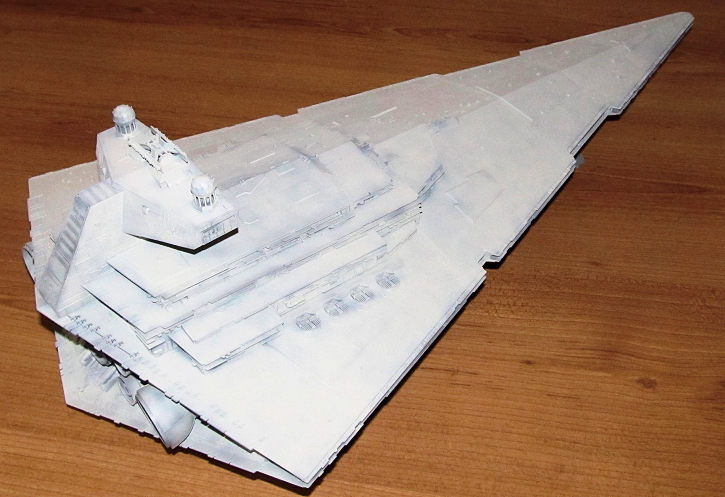 With a length of 1,600 meters, the wedge-shaped
Imperial I-class Star Destroyer was 445 meters longer than its immediate
predecessor, the Venator-class Star Destroyer, which had been developed for the
Galactic Republic during the Clone Wars. In keeping with the Empire's habit of
favoring muted colors whenever possible, the hull of the Imperial-class was
painted in gray, while the Venator-class of the Clone Wars-era had red markings
denoting the Republic's diplomatic immunity.
With a length of 1,600 meters, the wedge-shaped
Imperial I-class Star Destroyer was 445 meters longer than its immediate
predecessor, the Venator-class Star Destroyer, which had been developed for the
Galactic Republic during the Clone Wars. In keeping with the Empire's habit of
favoring muted colors whenever possible, the hull of the Imperial-class was
painted in gray, while the Venator-class of the Clone Wars-era had red markings
denoting the Republic's diplomatic immunity.
Imperial I-class Star Destroyers had over 37,000 crew on board— 9,253 officers and 27,850 enlisted personnel. The complement of 9,700 stormtroopers added to a total of 46,803 crew and passengers. With the bridge being located in the upper half of the ship, the officer's quarters were located right below it. To complement its impressive crew size, every Imperial-class vessel carried consumables for 2 years, with its liquid stores and holds for raw materials being located near its bow. Amidships, troop barracks, gunnery crew quarters, meeting rooms, training areas, and cell blocks were located in the vessels second 'step,' with four gradually upsloping smaller 'steps' eventually leading to the ships 'neck' which connected it to its upper bridge section, deflector shield generators, and communications array. On the "side" of the ship existed the port lateral umbilical restocking vestibule.
Like other Star Destroyers, a single Internal Affairs officer was stationed aboard the ship to scan the crew for signs of disloyalty and sedition, as well as interrogate any captured prisoners. As most ships in the Navy, Rebaxan Columni MSE-6 series repair droids were employed to serve as messenger, repair and custodial assistants.
 The Imperial-class Star Destroyer bristled with
weapons emplacements. 60 Taim & Bak XX-9 heavy turbolaser batteries, 60 Borstel
NK-7 ion cannons, and 10 Phylon 07 tractor beam projectors dotted its gray hull.
At the very front of the ship existed the forward pursuit tractor beam array.
The ship also featured six dual heavy turbolaser turrets, two quad heavy
turbolasers, three triple medium turbolasers, and two medium turbolasers. The
Imperial I-class also featured two dual heavy ion cannon turrets that lined the
ventral superstructure flanking the command tower. The turbolaser turrets of an
ISD were hooked to large arrays of auxiliary power cells. At both "ends" of the
Star Destroyer existed an aft starboard point defense laser canon.
The Imperial-class Star Destroyer bristled with
weapons emplacements. 60 Taim & Bak XX-9 heavy turbolaser batteries, 60 Borstel
NK-7 ion cannons, and 10 Phylon 07 tractor beam projectors dotted its gray hull.
At the very front of the ship existed the forward pursuit tractor beam array.
The ship also featured six dual heavy turbolaser turrets, two quad heavy
turbolasers, three triple medium turbolasers, and two medium turbolasers. The
Imperial I-class also featured two dual heavy ion cannon turrets that lined the
ventral superstructure flanking the command tower. The turbolaser turrets of an
ISD were hooked to large arrays of auxiliary power cells. At both "ends" of the
Star Destroyer existed an aft starboard point defense laser canon.
On the underside of the very tip of the ISD was the navigational deflector generator. It worked in tandem with the two bridge deflector shield domes. It carried shields strong enough to easily withstand a crash with a GR-75 medium transport with no damage to the hull.
Within its vast belly hangar bays, an Imperial-class Star Destroyer typically carried an impressive complement of troops, consisting of seventy-two TIE/ln space superiority starfighters, eight Lambda-class T-4a shuttles , twenty AT-AT walkers, thirty AT-ST or AT-DP walkers, and fifteen Imperial Troop Transports. Despite its fighter complement, Imperial I-class vessels proved less effective against skilled rebel pilots than their Venator-class predecessors had been against droid starfighters. They were nonetheless essential in the Imperial doctrine of planetary containment and fast infantry deployment, and the vessel was noted as one of the most resource-intensive ships in the Imperial Navy.
Powering the Destroyer were seven main engine
units, including Cygnus Spaceworks Gemon-4 ion engines, and could accelerate to
speeds of up to 975 kph (?!!!!?). The ship however was not suited towards
planetary atmospheres, in which full power was required to stay aloft. Any
interruption in the power s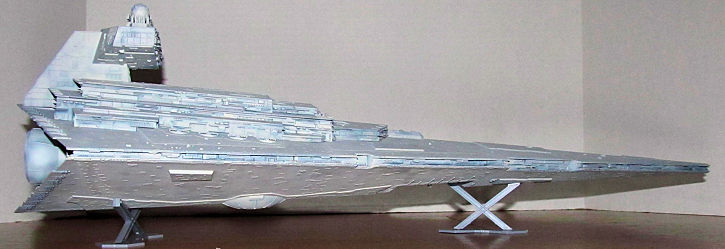 upply in atmosphere could be catastrophic to the
vessel, despite all vital equipment being shielded. The primary power generator
on board the ship was large enough relative to the rest of the craft to protrude
with a ventral bulb. In order to jump to light-speed and enter hyperspace the
Imperial-class was equipped with a Class 2 hyperdrive, while it was standard
protocol to dump the ship's garbage before entering hyperspace in order to
reduce the weight of the vessel.
upply in atmosphere could be catastrophic to the
vessel, despite all vital equipment being shielded. The primary power generator
on board the ship was large enough relative to the rest of the craft to protrude
with a ventral bulb. In order to jump to light-speed and enter hyperspace the
Imperial-class was equipped with a Class 2 hyperdrive, while it was standard
protocol to dump the ship's garbage before entering hyperspace in order to
reduce the weight of the vessel.
A prominent feature of the Imperial-class was its bridge tower. Located atop the tower were twin deflector shield generator globes and a tractor beam targeting array. On the command bridge, most of the crew worked in sunken pits below floor level, while senior officers could view the endless depths of space through wide viewports. This arrangement was considered beneficial for denoting rank hierarchy within the ship. A small room behind the main bridge existed separated by a single blast door, which had access to advanced communications equipment and a holographic imaging table.
In draft scripts for the film that would become
Star Wars, the term "Stardestroyer" refers to two-man fighters flown by what
would become the Galactic Empire. The film's second draft features four Star
Destroyers chasing a single Rebel ship, but the tremendous costs incurred by
Industrial Light & Magic (ILM) when production began helped lead Lucas to use a
single "terrifyingly large" Star Destroyer instead of four. ILM built a
91-centimeter (36 in) shooting model that was about half the size of the model
for the Tantive IV the Star Destroyer was chasing. Lucas asked ILM to build a
larger Star Destroyer model to match the Tantive IV's scale, but ILM convinced
him that the Dykstraflex camera
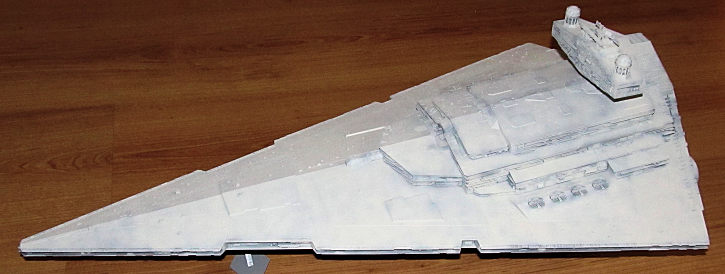 invented for the film made this unnecessary.
Nevertheless, they added additional hull details to the Star Destroyer model.
The 13-second opening shot was the first special effects piece ILM completed and
its success was an essential test for the Dykstraflex.
invented for the film made this unnecessary.
Nevertheless, they added additional hull details to the Star Destroyer model.
The 13-second opening shot was the first special effects piece ILM completed and
its success was an essential test for the Dykstraflex.
ILM built a 259-centimeter (102 in) Star Destroyer, equipped with internal lighting to provide a better sense of scale, for The Empire Strikes Back (1980). During production, Lucas decided that every Star Wars film would open in space with a shot of a Star Destroyer. The Empire Strikes Back also introduces the "Super Star Destroyer", also referred to as a "Star Dreadnought". The shooting model for the Super Star Destroyer Executor in The Empire Strikes Back and Return of the Jedi was 282 centimeters (111 in) long.
The design of the Venator-class Star Destroyers appearing in Revenge of the Sith (2005) are meant to bridge the appearance of the Acclamator-class transports in Attack of the Clones (2002) and the Imperial class in the original trilogy.
From Wookieepedia
| THE KIT |
See George Oh's preview of this massive kit. I might have studied Russian (poorly) but I didn't need to relearn the Cyrillic alphabet to follow the instructions.
| CONSTRUCTION |
I started by cutting the engine bell parts off the sprue and sanding off the sprue nubs. The parts needed a little bit of polishing with 3200 grit pads to remove most of the visible scratches. The three large two piece engine bells were assembled and put aside. Next up I cut off the shield generators and glued them together and sanded them to remove some of the mold marks along the seam. Only a little bit of sanding was required (be careful about the details.)
The main hull comes in four pieces. The top and
bottom halves of the forward portion of the wedge and the top and bottom halves
of the rear. I glued the top pieces together and the bottom pieces together. The
rest of the main hull was built layer upon layer. All the sidewall parts needed
to have t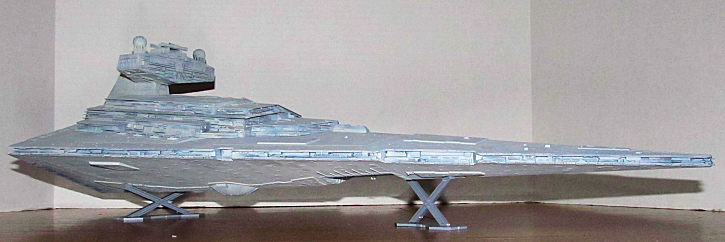 heir sprue nubs carefully removed and sanded flat so that there would
be no gaps as the parts fit very well. When the side walls were done, I glued
the internal supports to the bottom of the hull to prevent the hull from flexing
(great engineering decision by Zvezda.) Once set up the top and bottom halves of
the hull were glued together.
heir sprue nubs carefully removed and sanded flat so that there would
be no gaps as the parts fit very well. When the side walls were done, I glued
the internal supports to the bottom of the hull to prevent the hull from flexing
(great engineering decision by Zvezda.) Once set up the top and bottom halves of
the hull were glued together.
There was some seams that needed work. The most prominent one was the top and bottom seam where the nose assembly mated to the rest of the star destroyer. I used Vallejo plastic putty to fill in that seam, removed the excess with damp Q-tips and then when dry I carefully sanded it relatively smooth to blend the two halves together. The reactor core piece (round piece prominent at the rear bottom hull) did not fit so well and needed to have the gaps willed in with Vallejo plastic putty as well. The remaining seams were along the sidewalls where the top and bottom sections of the hull met. I took care of that with some flat plastic card strips that were cut to fit and covered up the seams.
After that I glued the control tower together along with the secondary deck, sensor array and the shield generators, but did not secure it to the main hull. Lastly I removed, sanded and glued on the turbo laser turrets.
| COLORS & MARKINGS |
I first preshaded the various sub assemblies (three engine bells, cargo deck clamps, secondary deck with control tower and main hull) with Tamiya flat and gloss black and Model Master Acrylic Gunmetal. This took three sessions and almost an hour to do each time.
When I had the chance I used Model Master Acrylic
FS36622 Camo Grey to paint the entire star destroyer with the intent to make the
paint coverage splotchy to break up the monotone color scheme. I sprayed and
sprayed and sprayed to make the splotchy paint look subtle (especially on the
sidewall 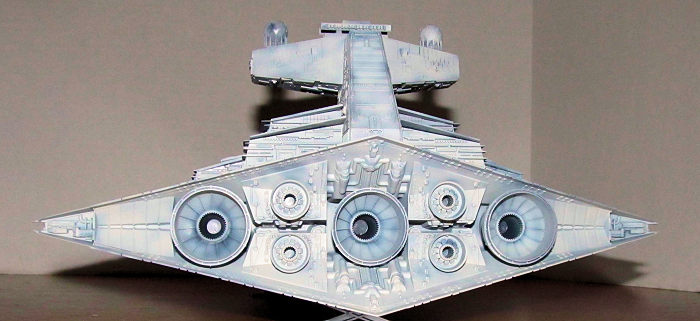 details) and that took about three sessions and about four hours to get
all the subsections and top/bottom to look the way I wanted it. I used about 3/4
of the contents of the paint jar to get coverage on the entire model.
details) and that took about three sessions and about four hours to get
all the subsections and top/bottom to look the way I wanted it. I used about 3/4
of the contents of the paint jar to get coverage on the entire model.
The engine bells needed to look more “heat scored” and worn, so I tried my best to make them worn. I over emphasized the seam lines and let the preshading appear through the paint more.
For the final bits, I glued the engine bells to the mountings in the stern, but did not glue the secondary deck with control tower to the top section of the hull to facilitate storage or modifications. The last work required was gluing the cargo clamps to the interior of the cargo bay at the bottom of the hull. I used the inadequate kit stands till I can make one of my own.
| CONCLUSIONS |
This is one huge kit and the largest I've personally built to date. It is a very easy build as it seemed to be designed for the Star Wars fanboy/fangirl in mind and doesn't require much work as long as you are careful removing the pieces off the sprues and sanding off the sprue nubs. Finding a place to park it isn't as easy though. Definitely for the Star Wars fan who has the wallet and space to build one of these.
A final note: Revell Germany is re-releasing or has re-released this kit for the European/North American Market sometime during the late spring/early summer.
13 June 2017
Copyright ModelingMadness.com
If you would like your product reviewed fairly and fairly quickly, please contact the editor or see other details in the Note to Contributors.
Back to the Main Page Back to the Review Index Page Back to the Previews Index Page